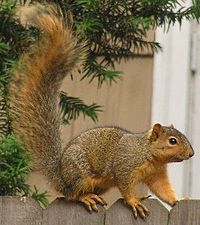Hodgson's giant flying squirrel
| Hodgson's giant flying squirrel | |
|---|---|

| |
| Scientific classification | |
| Kingdom: | |
| Phylum: | |
| Class: | |
| Order: | |
| Family: | |
| Genus: | |
| Species: | P. magnificus
|
| Binomial name | |
| Petaurista magnificus (Hodgson, 1836)
| |
Hodgson's giant flying squirrel (Petaurista magnificus) is a species of rodent in the family Sciuridae. It is found in mountainous areas of northern India, Nepal, Bhutan, Myanmar and southern China. Its natural habitat is tropical and subtropical forests, where it is threatened by habitat destruction.
Description
This large flying squirrel has a head-and-body length of 360 to 420 mm (14 to 17 in) and a tail length of 415 to 480 mm (16 to 19 in). It weighs about 1,350 g (48 oz). The fur on the back is dark brown with a black vertebral stripe and yellowish-brown patches on the shoulder. The flanks and gliding membranes are dark reddish-brown while the underparts and limbs are pale reddish-brown. The tail is dark brown at the base, the rest being reddish-brown, apart from the tip which is black. The feet are also black.[2]
Distribution and habitat
Hodgson's giant flying squirrel is native to the Himalayan regions of Nepal, northern India, Bhutan and the Tibet Autonomous Region at altitudes of between 1,500 and 3,000 m (4,900 and 9,800 ft). It also occurs in western Myanmar. Its habitat is tropical and subtropical evergreen forest and deciduous forest.[1]
Behaviour
Hodgson's giant flying squirrel is a nocturnal species. At dusk its booming calls can be heard as it emerges from its daytime hiding place in the canopy. It then glides down from the treetops to the rhododendrons and bushes growing below; the glide may cover a distance of as much as 100 m (330 ft) and terminates with a short upward movement.[2] The squirrel feeds on leaves, buds, grasses, flowers and fruits. It nests in circular holes up to 15 m (50 ft) above the ground, lined with soft vegetation. Little is known of its reproductive behaviour. They use little flaps of skin to fly.[2]
Status
The total number of Hodgson's giant flying squirrels is thought to be decreasing as its forest habitat is destroyed to make way for the cultivation of plantation crops such as tea and cardamom. However it has a wide distribution and the total number of animals are likely to be large, so the International Union for Conservation of Nature has assessed its conservation status as being of "least concern".[1]
References
- ^ a b c "Petaurista magnificus". IUCN Red List of Threatened Species. 2010. IUCN: e.T16721A6315419. 2010. doi:10.2305/IUCN.UK.2010-2.RLTS.T16721A6315419.en. Retrieved 27 August 2016.
{{cite journal}}: Unknown parameter|authors=ignored (help) - ^ a b c Smith, Andrew T.; Xie, Yan; Hoffmann, Robert S.; Lunde, Darrin; MacKinnon, John; Wilson, Don E.; Wozencraft, W. Chris (2010). A Guide to the Mammals of China. Princeton University Press. p. 178. ISBN 1-4008-3411-2.




